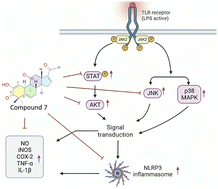Sesquiterpenoids and hexanorcucurbitacin from Aquilaria malaccensis agarwood with anti-inflammatory effects by inhibiting the STAT1/AKT/MAPK/NLRP3 pathway†
Abstract
Seven unknown compounds 1–7, including four sesquiterpenoids, one azulene-type, one indene-type, and one rare hexanorcucurbitacin, together with eleven knowns ones (8–16), were isolated from the agarwood chips of Aquilaria malaccensis. The structures of the isolated compounds were elucidated by extensive spectroscopic methods such as mass spectrometry, UV, IR, NMR spectroscopy. The precise stereo-chemical configurations of new compounds were determined by calculated ECD spectra data, as well as a single-crystal X-ray diffraction analysis. The isolated compounds 1–7 were evaluated by estimating the levels of nitric oxide (NO), TNF-α, and the expression of enzyme iNOS, and COX-2. Among them, a rare hexanortriterpenoid (7) derived from a cucurbitane-type triterpenoid showed the significantly attenuated neuro-inflammatory effects via the STAT1/AKT/MAPK/NLRP3 signaling pathway on the mechanistic studies.



 Please wait while we load your content...
Please wait while we load your content...